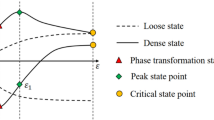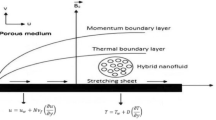Abstract
The behavior of saturated, porous media under dynamic or quasi-static loads was firstly formulated by Biot. Based on Biot’s theory, various possible simplifications have been proposed such as neglecting the second time derivative of the relative displacement. In addition, an even more simplified version has been proposed where the inertial terms in the generalized Darcy’s law are neglected as well. This paper aims to explore the advantages and limitations of that simplified formulation with the help of a linear one-dimensional (1D) poroelastic column subjected to periodic dynamic loading. Two non-dimensional parameters which are related to the permeability, excitation frequency, and material properties are introduced, and the analytical solutions are obtained and depicted graphically in cases of varied permeability and frequencies. Subsequently, a schematic diagram is developed to serve as guideline to determine whether the simplification is tenable, or the only meaningful solution is available by complete Biot’s theory.









Similar content being viewed by others
Abbreviations
- σ ij :
-
Total stress tensor (tension positive)
- \( \alpha \) :
-
Biot coefficient
- δ ij :
-
Kronecker delta
- ɛ ij :
-
Strain tensor
- \( M \) :
-
Biot modulus
- n :
-
Porosity
- \( \rho \) :
-
Bulk density of mixture
- g :
-
Gravity acceleration
- \( w_{i} \) :
-
Relative displacement
- \( q_{i} \) :
-
Specific flux
- ρ a :
-
Apparent mass density
- \( \varOmega \) :
-
\( M/\left( {E + \alpha^{2} M} \right) \)
- \( \beta_{2} \) :
-
\( \rho_{a} /\rho \)
- \( ND_{1} \) :
-
\( 2\rho \kappa T/\left( {n\pi \hat{T}^{2} } \right) \)
- T :
-
\( 2\pi /\omega \)
- \( V_{c}^{2} \) :
-
\( \left( {E + \alpha^{2} M} \right)/\rho \)
- \( \sigma_{ij}^{\prime } \) :
-
Effective stress tensor (tension positive)
- \( p_{f} \) :
-
Pore pressure (compression positive)
- \( \lambda \), \( \mu \) :
-
Lame constants
- \( u_{i} \) :
-
Solid displacement tensor
- \( \zeta \) :
-
Variation of fluid content
- \( e \), \( \theta \) :
-
Volumetric strains of solid and fluid
- \( \rho_{\text{s}} \), \( \rho_{\text{f}} \) :
-
Real density of solid and fluid
- \( \kappa \) :
-
Intrinsic permeability
- \( k \) :
-
Permeability coefficient
- \( \mu_{\text{f}} \) :
-
Fluid viscosity
- \( \omega \) :
-
Angular frequency
- \( \beta_{1} \) :
-
\( \rho_{f} /\rho \)
- \( \bar{z} \) :
-
z/L
- \( ND_{2} \) :
-
\( \pi^{2} \left( {\hat{T}/T} \right)^{2} \)
- \( \hat{T} \) :
-
\( 2L/V_{\text{c}} \)
- E, \( \nu \) :
-
Elastic modulus and Poisson ratio
References
Biot MA (1941) General theory of three-dimensional consolidation. J Appl Phys 2(12):155–164
de Boer R, Ehlers W (1988) Review article a historical review of the formulation of porous media theories. Acta Mech 74:1–8
de Boer R (2004) Theory of porous media—highlights in the historical development and current state. Springer, Berlin
Biot MA (1956) Theory of propagation of elastic waves in a fluid-saturated porous solid. I. Low-frequency range. J Acoust Soc Am 28(2):168–178
Biot MA (1956) Theory of propagation of elastic waves in a fluid-saturated porous solid. II. Higher frequency range. J Acoust Soc Am 28(2):179–191
Bowen RM (1982) Compressible porous media models by use of the theory of mixtures. Int J Eng Sci 20(6):697–735
Bowen RM (1980) Incompressible porous media models by use of the theory of mixtures. Int J Eng Sci 18(9):1129–1148
Ehlers W, Kubik J (1994) On finite dynamic equations for fluid-saturated porous media. Acta Mech 105:101–117
Schanz M (2009) Poroelastodynamics: linear models, analytical solutions, and numerical methods. Appl Mech Rev 3(62):1–15
Garg SK, Nayfeh AH, Good AJ (1974) Compressional waves in fluid-saturated elastic porous media. J Appl Phys 45(5):1968–1974
Schanz M, Cheng HD (2000) Transient wave propagation in a one-dimensional poroelastic column. Acta Mech 145(1–4):1–18
Zienkiewicz OC, Chang CT, Bettess P (1980) Drained undrained, consolidating and dynamic behavior assumptions in soils. Geotechnique 4:385–395
Schanz M, Braunschweig A (2000) Transient wave propagation in a one-dimensional poroelastic column. Acta Mech 145:1–18
Schanz M, Struckmeier V (2005) Wave propagation in a simplified modelled poroelastic continuum: fundamental solutions and a time domain boundary element formulation. Int J Numer Methods Eng 64(13):1816–1839
Lubich C (1988) Convolution quadrature and discretized operational calculus. I. Numer Math 52:129–145
Lubich C (2004) Convolution quadrature revisited. Numer Math 44:503–514
Bowen RM, Lockett RR (1983) Inertial effects in poroelasticity. J Appl Mech 50:334–342
Zienkiewicz OC, Shiomi T (1984) Dynamic behavior of saturated porous media. The generalized Biot formulation and its numerical solution. Int J Numer Anal Methods Geomech 8:71–96
Group I C (2006) FLAC3D-fast Lagrangian analysis of continua in 3 dimension. User’s Guide, Minneapolis
Chao H, Yan-Guo Z, Yun-Min C (2010) Numerical simulation of centrifuge-shaking table test on saturated sand. In: International conference on E-product E-service and E-entertainment
Byrne PM, Park S, Beaty M (2004) Numerical modeling of liquefaction and comparison with centrifuge tests. Can Geotech J 41(2):193–211
Bonnet G, Auriault JL (1985) Dynamics of saturated and deformable porous media. In: Boccara N, Daoud M (eds) Physics of finely divided matter. Springer proceedings in physics, vol 5. Springer, Berlin, Heidelberg
Kim YK, Kingsbury HB (1979) Dynamic characterization of poroelastic materials. Exp Mech 19(7):252–258
Author information
Authors and Affiliations
Corresponding author
Additional information
Publisher’s Note
Springer Nature remains neutral with regard to jurisdictional claims in published maps and institutional affiliations.
Electronic supplementary material
Below is the link to the electronic supplementary material.
Appendix: Analytical Solution in Time Domain by Convolution Quadrature Method
Appendix: Analytical Solution in Time Domain by Convolution Quadrature Method
Generally, the response in time domain can be calculated using the convolution integral as below,
where \( {\mathcal{L}}^{ - 1} \) is the inverse Laplace transform operator and \( s \) is the complex Laplace variable.
We found the response function in the convolution integral (24)–(25) is only available in Laplace domain and force function in time domain and a numerical inverse Laplace transformation is necessary. It is preferable to take the “Convolution Quadrature Method” proposed by Lubich, and this numerical method approximates the convolution integral numerically by a quadrature formula,
where \( N \) is divide time t by time increment \( \Delta t \) and weights \( \omega_{n - k} \left( {\Delta t} \right) \) are determined with the help of Laplace-transformed impulse response function \( \hat{u}_{z} \left( {s,z} \right) \) and a linear multistep method \( \gamma \left( s \right) \) published by Lubich [15, 16], as
where \( {\mathcal{R}} \) is the radius of a circle in the domain of analyticity of \( \hat{u}_{z} \) and function \( \gamma \left( s \right) \) is the polynomial of the multistep method.
The used parameters can be found in Ref. [13], i.e., \( \gamma \left( s \right) = {\raise0.7ex\hbox{$3$} \!\mathord{\left/ {\vphantom {3 2}}\right.\kern-0pt} \!\lower0.7ex\hbox{$2$}} - 2s + {\raise0.7ex\hbox{$1$} \!\mathord{\left/ {\vphantom {1 2}}\right.\kern-0pt} \!\lower0.7ex\hbox{$2$}}s^{2} \), \( L = N \), \( {\mathcal{R}}^{N} = \sqrt \varepsilon \), \( \varepsilon = 10^{ - 10} \), which is tested against the time domain solution for the particular case with infinite permeability and has produced favorable comparison with small time increment \( \Delta t \).
Rights and permissions
About this article
Cite this article
Hu, D., Zhang, K. & Li, F. Dynamic Behavior of Saturated Poroelastic Continuum by Simplified Formulation of Biot’s Theory. Indian Geotech J 49, 455–466 (2019). https://doi.org/10.1007/s40098-019-00354-w
Received:
Accepted:
Published:
Issue Date:
DOI: https://doi.org/10.1007/s40098-019-00354-w




